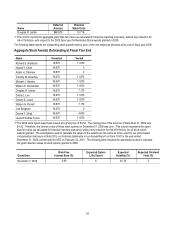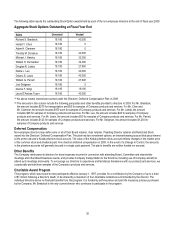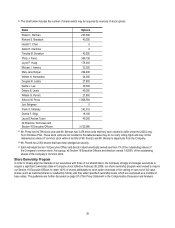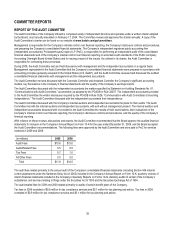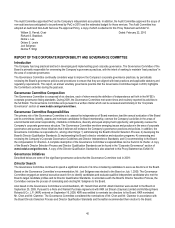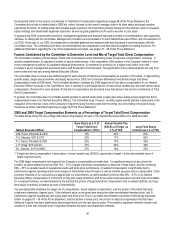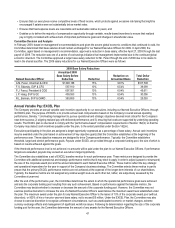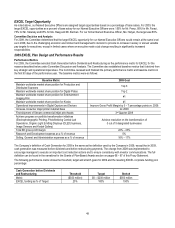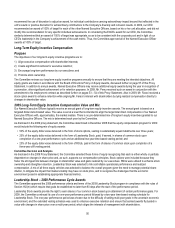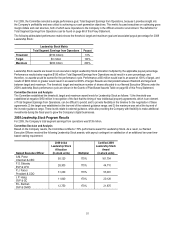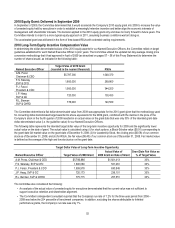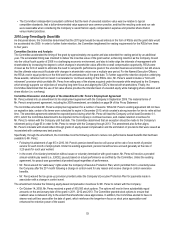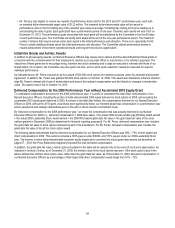Kodak 2009 Annual Report Download - page 188
Download and view the complete annual report
Please find page 188 of the 2009 Kodak annual report below. You can navigate through the pages in the report by either clicking on the pages listed below, or by using the keyword search tool below to find specific information within the annual report.
44
• Compensation programs are designed and administered to appropriately balance risk taking with the achievement of objectives
in the interest of shareholders.
While this was not a new objective, the Committee determined that it is appropriate to specifically articulate the manner in which it has
operated, and will continue to operate, in its ongoing oversight of executive compensation plan design and administration. The Committee
also reaffirmed the following existing principles:
• Aggregate total direct compensation, consisting of base salary, annual variable pay and long-term equity incentives, should be at
a competitive median level while maintaining flexibility to selectively target compensation for key positions at the 75th percentile.
• A significant portion of each executive’s compensation should be variable, with a positive correlation between the degree of
variable compensation and the level of the executive’s responsibility. In other words, the senior-most executives, who are the
most responsible to shareholders, are held most accountable to changes in shareholder value and achievement of critical
performance goals.
• Interests of executives should be aligned with those of the Company’s shareholders by providing long-term equity incentives and
encouraging executives to acquire and maintain a requisite level of stock ownership.
• Compensation should be linked to key operational and strategic metrics of the Company’s business plan, along with behavioral
expectations.
• Compensation program design should ensure high standards of excellence and consider best practices.
The Committee also reviewed the primary basis for individual differentiation of executive compensation and reaffirmed the manner in which
base salaries and annual variable pay is differentiated among our executives. The elements of differentiation are:
• Base salaries – internal and external relative responsibility and experience;
• Annual variable pay – Company performance, unit level performance (where applicable) and individual performance; and
• Long-term equity incentives – Company performance and relative responsibility.
2009 Executive Compensation Decisions
The Committee made the following decisions impacting 2009 compensation, which are described and referred to within this discussion as
the “2009 Awards.”
2009 Executive Compensation Decision Timeline
Committee Meeting
Compensation Determination
2009 Stock Option Award (December 2008 Committee grant date)
2009 January Leadership Stock allocation (performance stock unit plan)
December 2008
2009 January RSU Award
2009 Base Salary consideration
February 2009
2009 Annual Variable Pay (Executive Compensation for Excellence and Leadership (EXCEL)) target
opportunity
April 2009
2009 Named Executive Officer Base Salary reduction action for remainder of 2009
2010 Long-Term Equity Awards
September 2009
Amendment to Mr. Perez’s employment agreement
2009 EXCEL Award Certification and Named Executive Officer Awards
February 2010
2009 Leadership Stock Certification and Named Executive Officer Awards
DETERMINING EXECUTIVE TOTAL DIRECT COMPENSATION
The Committee oversees the Company’s executive compensation strategy and reviews and approves the compensation of our Named
Executive Officers. Typically, the Committee reviews the total compensation of each Named Executive Officer against market data for base
salary, target total cash and total long-term incentive opportunity on an annual basis. In preparation for the Committee’s review in 2009, the
Committee recognized that 2009 market data was not likely to provide reliable market trend information because of the unusual economic
situation and the time lag in the reporting of actual practice as reflected in available data. As such, the Committee did not request that its
independent consultant conduct an updated analysis of market compensation rates in 2009, nor did it request the independent consultant
to update or present any compensation surveys to the Committee in 2009. In making this decision, the Committee sought the advice and
input of its independent consultant, who agreed that the path forward was reasonable given the unusual economic environment.


